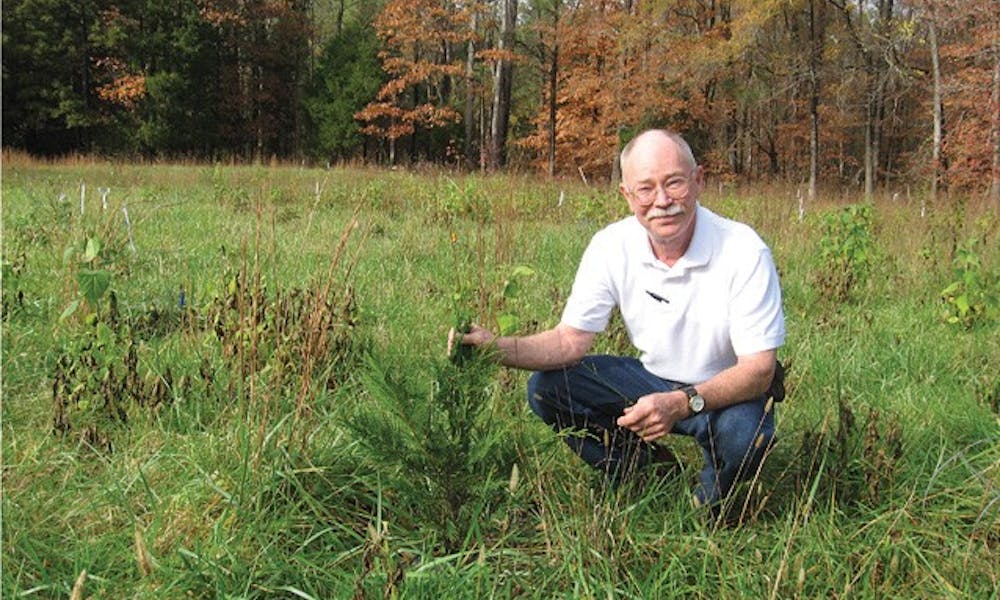In January 2008, Jon Shaffer, Joseph Williams and Jesse Leddick, who graduated from the Nicholas School of the Environment last Spring, hatched a plan to grow and sell organic Christmas trees to raise money for the activities of their club and bolster offerings in graduate forestry education.
Although all three founders celebrate Christmas, Williams said the spirit of the season wasn’t their primary motivation. Visions of a greener planet danced in their heads.
The students sold trees purchased from another farm last winter, raising the funds to plant 300 seedlings in January. The trees should be ready for harvest in about five years, Williams estimated, and 150 more saplings will be planted after Christmas.
The Duke Forestry Christmas Tree Farm sold 79 trees last year, raising $1,700, and Nicholas School Dean Bill Chameides was among the customers.
Duke Forest Manager Judson Edeburn maintains the two-acre parcel of land where the seeds have been sown. Even a seemingly innocuous task like mowing down the weeds requires great care.
“It just takes a lot of concentration to do that without damaging the little guys,” he said.
Eighty-one trees have already been pre-sold this year, and students expect to raise more than $2,000 to reinvest in the farm.
Nick DiLuzio, a second-year student in the Nicholas School who inherited the farm from its founders, is a self-described holiday addict who’s already listening to Christmas music. Until visiting local farms, he did not know the holiday foliage is rooted in big business.
“We used to go buy a Christmas tree from church every year, but that was about the extent of my knowledge,” DiLuzio said.
To hear him tell it, learning how most Christmas trees make it from the farmland to the lot was like learning the truth behind Santa Claus. Commercial farmers raise their saplings with a cocktail of pesticides, herbicides and fungicides, DiLuzio said.
“Most Christmas tree growers around here, for the most part they’re old white males, stuck in their ways,” he said. “They grow up using chemicals so they swear by chemicals.”
DiLuzio said many local farmers have laughed at the students’ plans to raise their trees organically.
“They don’t think it can be done—but we’re going to try,” he said.
Protecting the saplings without pesticides has been a challenge, Edeburn said. Students have gotten creative, sprinkling the soil with clippings from Duke Haircutters to suggest the presence of humans. Several trees have been tagged with white stickers to mimic the presence of a deer that has raised its tail in fear. The young trees are also caged in tomato wiring, which keeps hungry deer at a distance most of the year.
But Fall is different—Fall is mating season. Many young stags, crazed by hormones, have overturned the protective wiring to release their pent-up sexual frustration, Edeburn explained. Once exposed, the rest of the herd is free to graze.
A spindly Leyland Cypress has been bluntly pruned, its branches splintered by a doe’s teeth. It is one of many saplings that have fallen prey to the deer.
“Nick needs to get out here pretty soon, pretty soon,” Edeburn said nervously, noting that the trees’ protection needs reinforcing.
DiLuzio and his predecessors believe with conviction that respecting Mother Nature is the only way to raise a sapling.
If money grows on any tree, it is the Fraser Fir. The quintessential Christmas tree grows easily in the North Carolina mountains and is distributed all over the South to be sold for a hefty price, Edeburn said. But Williams said the students opted to plant native species like the Eastern Red Cedar instead, though they know the trees will fetch a smaller sum.
“We liked the idea of creating a local product,” he said. “We thought it would be a good idea to provide trees that would provide a lower carbon footprint.”
With a carefully crafted marketing campaign, Williams said the students hope to convince consumers that Christmas trees present a great opportunity to go green. Trees treated with pesticides take a toll on the environment, but the popularity of fake trees has dealt an even bigger blow.
Williams doesn’t claim to be a Christmas fanatic. But when he was a little boy, his family always opened gifts around a real Christmas tree.
“You go to the store now and see a tree in a box that says ‘Fresh cut Fraser Fir,’” he said. “The fact that advertisers can use those words to describe a tree made in China is ridiculous. We really like the idea of getting people back to what a Christmas tree should be.”
Edeburn notes that the Leyland Cypress taking root beneath his feet could serve as a tabletop tree or a six-foot-tall ceiling-scraper. For now, though, the tree is just a sapling, and the students’ plans aren’t fully formed, either. The future Christmas trees are too small to be seen from more than a few yards away, much less turn a profit
By the time the trees are ready to be replanted in a living room, DiLuzio will have long graduated. Williams and his co-founders are already far from campus.
“As foresters, we have to think long-term in terms of the value of the work that we do now—that’s been trained into us as a professional skill,” Williams said. “Forestry in general, you’re doing certain things to your tree lot, and you’re not going to see the benefits for a long time. That’s the fun of it. It really is fun.”
Get The Chronicle straight to your inbox
Signup for our weekly newsletter. Cancel at any time.

